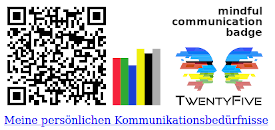Mediator
 Mediators are people who orient themselves holistically. For them, thinking and feeling go hand in hand. They use their empathy to empathize with what moves their interlocutors and their intellect to clarify meaning and contexts. When you communicate with a mediator, you have it easy: You just have to be open and honest.
Mediators are people who orient themselves holistically. For them, thinking and feeling go hand in hand. They use their empathy to empathize with what moves their interlocutors and their intellect to clarify meaning and contexts. When you communicate with a mediator, you have it easy: You just have to be open and honest.
The strongest motivations of a mediator are:
Communication
 If you want to know more about the mediator, use the pocket book: The motivational type “mediator” (german edition). Here you will get the important information about the basic needs and about the typical characteristics, relationships and communication of the mediator. In addition, you will read what the mediator can do for his well-being, how he learns most easily and which professions suit him. The book also includes a checklist for all important decisions.
If you want to know more about the mediator, use the pocket book: The motivational type “mediator” (german edition). Here you will get the important information about the basic needs and about the typical characteristics, relationships and communication of the mediator. In addition, you will read what the mediator can do for his well-being, how he learns most easily and which professions suit him. The book also includes a checklist for all important decisions.
In order to make communicative contexts transparent and understandable, the mindful communication badge has been developed as an intuitive helper.
 Would you like to get your own mindful communication badge for the signum of your emails? Just invest five minutes at https://mcb.senseaition.com. A mindful communication badge is of course free of charge.
Would you like to get your own mindful communication badge for the signum of your emails? Just invest five minutes at https://mcb.senseaition.com. A mindful communication badge is of course free of charge.
 If you want a detailed analysis of your personal motivations and basic needs and would like to go deeper into TwentyFive, you can purchase a motivation portrait according to TwentyFive. You can find explanations of TwentyFive in various books and, of course, from any specialist with a psychological education.
If you want a detailed analysis of your personal motivations and basic needs and would like to go deeper into TwentyFive, you can purchase a motivation portrait according to TwentyFive. You can find explanations of TwentyFive in various books and, of course, from any specialist with a psychological education.
With the tools of sense.AI.tion GmbH there are possibilities to use TwentyFive in everyday work. These facilitate processes of recruiting, personnel development, personnel management. In addition, the tools make communication transparent, understandable and bring you closer to customers and partners.
